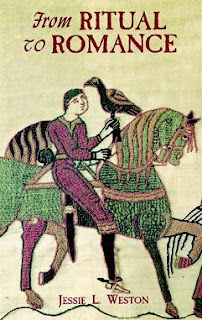From Ritual to Romance
 From Ritual to Romance, by Jessie L. Weston
From Ritual to Romance, by Jessie L. WestonI blame T. S. Eliot for this. References to "The Waste Land" constantly mentioned how the poem was partly inspired by Weston's landmark book about the legend of the Holy Grail, and put me in the mood to read it myself (and the same for Frazer's Golden Bough, which is now sitting by my bed). I have an old paperback of this book, which I read partway through back in college when I was auditing a course on Arthurian literature because it was given by my favorite professor. So when I opened the book again, I found a bookmark: a ticket to a 1995 performance of Rosencrantz and Guildenstern are Dead, which I remember enjoying very much. I must have seen it just before meeting my now-husband.
So. In 1920, Jessie Weston published the result of her decades of study (she was 70 at the time): a sort of anthropological and folkloric study of the roots of the Grail legend, with special emphasis on the mysterious figure of the Fisher King. I believe it was something of a hit at the time, and is still very influential, though I don't know how reliable she is considered these days. Certainly she is engaging in some long stretches, but I'm not qualified to judge them.
Weston links up all kinds of disparate traditions: folkloric sword and Morris dances are connected with ancient Sanskrit mythology, the Fisher King is compared with Adonis and Tammuz and all the ancient beliefs in a young god who died and rose again, the Doctor in medieval mystery plays is linked to Sir Gawain. And there are Tarot cards. All of these strands are brought to the point:
I am firmly and entirely convinced that the root origin of the whole bewildering complex is to be found in the Vegetation Ritual, treated from the esoteric point of vies as a Life-Cult, and in that alone. Christian Legend, and traditional Folk-Tale, have undoubtedly contributed to the perfected romantic corpus, but they are in truth subsidiary and secondary features...Weston believes that the Fisher King is a central figure to the Grail legend, and a direct descendant of fertility gods like Adonis, Osiris, and Tammuz who died and were brought back to life, bringing the land itself with them. (Looking this up on Wikipedia, it seems that folklorists have spent much of the past 100 years debating whether such a category of god even exists, and they think not, so this is pretty out of favor as a theory, I guess.)
It's quite an interesting book, although that might be because I like century-old folkloric speculation. I had fun reading it, and I'm going to have to read some Frazer too. (I really want to read Alfred Watkins--does anyone know of downloadable versions of his books? I believe they are out of copyright by now.)
One thing that really struck me about this book was its length. From Ritual to Romance is a masterpiece of brevity, cramming 30 years of obsessive research into about 200 pages of a pocket paperback. I grant you that these pages are densely written and not all that easy to follow! But I couldn't help thinking that if Weston was writing today, she would have to produce something about four times as long. 800 pages minimum, I'm figuring. I'm always complaining that modern non-fiction is too padded out, and this just makes me think so more.




This looks fascinating! I always learn so much from your blog. I really appreciate it!
ReplyDeleteThis looks fascinating! I always learn so much from your blog. I really appreciate it!
ReplyDelete